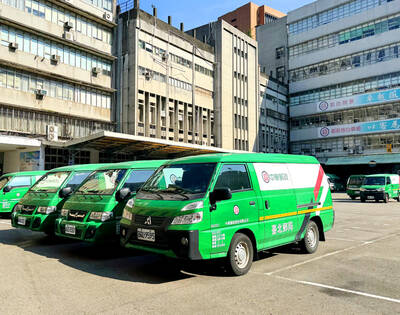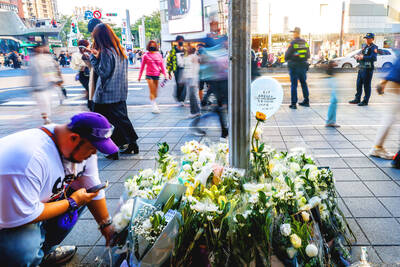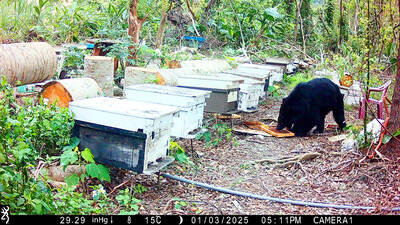China is developing a new class of helicopters that could pose a direct threat to Taiwan, a leading US military analyst said.
In the case of an attack, Taiwan would have much less time to mobilize its counter-invasion forces, said Richard Fisher, a senior fellow at the International Assessment and Strategy Center (IASC).
He says that at the China Helicopter Exposition held in Tianjin, China, earlier this month, Aviation Industries of China (AVIC) revealed two advanced helicopter concepts in model form — a quad-tilt rotor and a high-speed design.
While it could be some time before they are operational, their development is advanced enough to cause concern, he said.
“They are the result of an accelerated Chinese investment in helicopter technology that aims to raise indigenous design and production capabilities to world-class levels,” Fisher said.
In “China’s Advanced Helicopter Concepts” — published this week by the IASC — Fisher says that one of China’s new helicopters, known as the Blue Whale, will have a quad-tilt rotor design and a 20-tonne payload.
It is expected to have a range of 3,100km and a combat radius of 815km.
The Blue Whale will feature significant use of composite materials, “intelligent” avionics and flight controls and cabin noise levels similar to that of airliners.
Also unveiled in Tianjin was the high-speed Jueying-8 “Absolute Shadow,” which was described as an unmanned high-speed helicopter technology test platform.
It is expected to have a top speed of 450kph and may make its first flight in 2015.
“The emergence of a Chinese quad tilt rotor program points to potential Chinese strategic intentions,” Fisher wrote.
“It now appears, provided it can overcome technical challenges and sustain funding, that China may be the first to reap the strategic benefits of new concepts for heavy and fast vertical lift,” Fisher said.
He speculates that with a Blue Whale that could lift 20 tonnes at speeds of more than 480kph, the People’s Liberation Army (PLA) could be the first to deploy in a regional conflict.
It might, for example, occupy the Diaoyutai Islands (釣魚台列嶼) or capture airfields in the Sakashima Islands, which would allow larger transport aircraft to bring in heavy air defense and anti-ship ballistic missiles to thwart a Japanese-US attempt to retake the islands.
“From the Sakashimas, the Blue Whale could also spearhead a multi-axis attack to capture airfields on Taiwan with current light-weight Chinese Airborne mechanized forces, to ease the way for follow-on invasion forces,” Fisher said.
In an interview with the Taipei Times, Fisher said the emergence of the Blue Whale means the PLA could attempt to capture key targets in Taiwan like the Presidential Office or the National Security Bureau without first capturing airfields and ports.
“The ability of a platform like the Blue Whale to rapidly project both fighting vehicles and significant numbers of heavily armed infantry and special forces also means that Taiwan will have much less time to mobilize its counter-invasion forces,” he said.
Fisher said that if the PLA meets with success in developing tilt rotor technology, then consideration should be given by Taiwan to training police and militia in the use of shoulder-fired anti-armor and anti-aircraft missiles.
Taiwan should consider buying more of these weapons to ensure they are “immediately available” to counter PLA airborne invasion forces, he said.

SHIPS, TRAINS AND AUTOMOBILES: The ministry has announced changes to varied transportation industries taking effect soon, with a number of effects for passengers Beginning next month, the post office is canceling signature upon delivery and written inquiry services for international registered small packets in accordance with the new policy of the Universal Postal Union, the Ministry of Transportation and Communications said yesterday. The new policy does not apply to packets that are to be delivered to China, the ministry said. Senders of international registered small packets would receive a NT$10 rebate on postage if the packets are sent from Jan. 1 to March 31, it added. The ministry said that three other policies are also scheduled to take effect next month. International cruise ship operators

HORROR STORIES: One victim recounted not realizing they had been stabbed and seeing people bleeding, while another recalled breaking down in tears after fleeing A man on Friday died after he tried to fight the knife-wielding suspect who went on a stabbing spree near two of Taipei’s busiest metro stations, Taipei Mayor Chiang Wan-an (蔣萬安) said. The 57-year-old man, identified by his family name, Yu (余), encountered the suspect at Exit M7 of Taipei Main Station and immediately tried to stop him, but was fatally wounded and later died, Chiang said, calling the incident “heartbreaking.” Yu’s family would receive at least NT$5 million (US$158,584) in compensation through the Taipei Rapid Transit Corp’s (TRTC) insurance coverage, he said after convening an emergency security response meeting yesterday morning. National

PLANNED: The suspect visited the crime scene before the killings, seeking information on how to access the roof, and had extensively researched a 2014 stabbing incident The suspect in a stabbing attack that killed three people and injured 11 in Taipei on Friday had planned the assault and set fires at other locations earlier in the day, law enforcement officials said yesterday. National Police Agency (NPA) Director-General Chang Jung-hsin (張榮興) said the suspect, a 27-year-old man named Chang Wen (張文), began the attacks at 3:40pm, first setting off smoke bombs on a road, damaging cars and motorbikes. Earlier, Chang Wen set fire to a rental room where he was staying on Gongyuan Road in Zhongzheng District (中正), Chang Jung-hsin said. The suspect later threw smoke grenades near two exits

The Forestry and Nature Conservation Agency yesterday launched a gift box to market honey “certified by a Formosan black bear” in appreciation of a beekeeper’s amicable interaction with a honey-thieving bear. Beekeeper Chih Ming-chen (池明鎮) in January inspected his bee farm in Hualien County’s Jhuosi Township (卓溪) and found that more than 20 beehives had been destroyed and many hives were eaten, with bear droppings and paw prints near the destroyed hives, the agency said. Chih returned to the farm to move the remaining beehives away that evening when he encountered a Formosan black bear only 20m away, the agency said. The bear